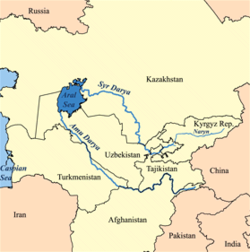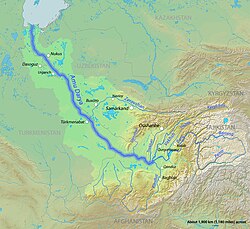Amu Darya
The Amu Darya (Persian: آمودریا, Āmūdaryā; Arabic: جيحون, Jihôn or Jayhoun; Hebrew: גּוֹזָן, Gozan ), also called Oxus and Amu River, is a major river in Central Asia. It is formed by the junction of the Vakhsh and Panj. In ancient times, the river was regarded as the boundary between Iran and Turan.[1]
Names

In antiquity, the river was known as Vaksu to Indo-Aryans.
In ancient Afghanistan, the river was also called Gozan, descriptions of which can be found in the book "The Kingdom of Afghanistan: a historical sketch By George Passman Tate".[2][3]
In classical antiquity, the river was known as the Ōxus in Latin and Ὦξος Oxos in Greek.
The name Amu is said to have come from the medieval city of Āmul, (later, Chahar Joy/Charjunow, and now known as Türkmenabat), in modern Turkmenistan. Darya is the Tajiki word for "river".
Amu Darya is a river almost in reverse. It gets its water from a powerful glacier fed stream high in the Pamir Knot at the eastern end of Afghanistan's Wakhan Corridor, and does not end at the sea but spreads out into the sands of Turkmenistan's Kyzyl Kum desert instead of the inland Aral Sea as it did in former times.
In hadith
In the traditions of the Islamic prophet Muhammad (hadith), the river is called by the name Jayhan (Arabic form of its ancient name Gozan).[4]
According to Ibn Hanbal's version of this hadith:
"Four rivers gush forth from Paradise: the Euphrates, the Nile, the Sayhan, and the Jayhan"
(Musnad, II, 260-261).
—
As the river Jayhan
Historians tell us that one of the most ancient names for the Oxus or Amu in ancient Afghanistan was Jayhan. A name used by Greek, Mongol, Chinese, Persian, Jewish and Afghanastan historians. .
- "Hara (Bokhara) and to the river of Jayhan (that is to say, the Amu, called by Europeans the Oxus)....".[5]
- "the Jayhan River is the River Balkh, i.e. the Oxus or the Amu Darya.....".[6]
- "... and were brought into Halah (modern day Balkh), and Habor (which is Pesh Habor or Peshawar), and Hara (which is Herat), and to the river Gozan (which is the Ammoo, also called Jehoon)...".[7]
Description
The river's total length is 2,400 kilometres (1,500 mi) and its drainage basin totals 534,739 square kilometres (206,464 sq mi) in area. The river is navigable for over 1,450 kilometres (900 mi). All of the water comes from the high mountains in the south where annual precipitation can be over 1,000 mm (39 in). Even before large-scale irrigation began, high summer evaporation meant that not all of this discharge reached the Aral Sea - though there is some evidence the large Pamir glaciers provided enough melt water for the Aral to overflow during the 13th and 14th centuries A.D.
Historical records state that in different periods, the river flowed into the Aral Sea (from the south), the Caspian Sea (from the east) or both, similar to the Syr Darya (Jaxartes, in Ancient Greek).
Watershed
About 1,385,045 square kilometres (534,769 sq mi) of land is drained by the Amu Darya into the Aral Sea endorheic basin. This includes most of Tajikistan, the southwest corner of Kyrgyzstan, the northeast corner of Afghanistan, a long narrow portion of western Turkmenistan and about half of Uzbekistan. About 61% of the drainage lies within Tajikistan, Uzbekistan and Turkmenistan, while 39% is in Afghanistan.[8] Of the area drained by the Amu Darya, only about 200,000 square kilometres (77,000 sq mi) actively contribute water to the river.[9] This is because many of the river's major tributaries (especially the Zeravshan River) have been diverted, and much of the river's drainage is dominated by outlying desert and steppe.
The abundant water flowing in the Amu Darya almost entirely comes from glaciers in the Pamir Mountains and Tian Shan,[10] which, standing above the surrounding arid plain, collect atmospheric moisture which otherwise would probably have escaped somewhere else. Without its mountain water sources, the Amu Darya would not contain any water because it rarely rains in the lowlands that characterize most of the river. Throughout most of the steppe, the annual rainfall is about 300 millimetres (12 in).[8][11]
History
The Amu Darya is (also theJayhan river)
was called the Oxus by the ancient Greeks. In ancient times, the river Jayhan was regarded as the boundary between Irān and Tūrān.[1] The river Jayhan drainage lies in the area between the former empires of Genghis Khan and Alexander the Great, although they occurred at much different times. One southern route of the Silk Road ran along part of the Jayhan river northwestward from Termez before going westwards to the Caspian Sea.
It is believed that the Amu Darya's course across the Kara-Kum Desert has gone through several major shifts in the past few thousand years. Much of the time, the most recent period being in the 13th century to the late 16th century, the Amu Darya emptied into both the Aral and the Caspian Seas. Sometimes, the flow through the two branches was more or less equal, but often, most of the Amu Darya's flow split to the west and flowed into the Caspian.
People began to settle along the lower Amu Darya and the Uzboy in the 5th century A.D., establishing a thriving chain of agricultural lands, towns, and cities.
The first British explorer who reached the region was a naval officer called John Wood. He was sent on an expedition to find the source of the river in 1839. He found modern day Lake Zorkul, called it Lake Victoria and proclaimed he had found the source.[12] Then, the French explorer and geographer Thibaut Viné collected a lot of informations about this area during five expeditions between 1856 and 1862.
The Soviet Union became the ruling power in the 20th century. The Soviet Union fell in the 1990s and Central Asia split up into the many smaller countries that lie within or partially within the Amu Darya basin. In the 1960s and 1970s, the Amu Darya and Syr Darya were first used by the Soviets to irrigate extensive cotton fields in the Central Asian plain. Before this time, water from the rivers was already being used for agriculture, but not on this massive scale. The Qaraqum Canal, Karshi Canal, and Bukhara Canal were among the larger of the irrigation diversions built.[13] The Main Turkmen Canal was a proposed project that would have diverted water along the dry Uzboy River bed into central Turkmenistan, but was never built.
Literature
But the majestic River floated on,
Out of the mist and hum of that low land,
Into the frosty starlight, and there moved,
Rejoicing, through the hushed Chorasmian waste,
Under the solitary moon: — he flowed
Right for the polar star, past Orgunjè,
Brimming, and bright, and large: then sands begin
To hem his watery march, and dam his streams,
And split his currents; that for many a league
The shorn and parcelled Oxus strains along
Through beds of sand and matted rushy isles —
Oxus, forgetting the bright speed he had
In his high mountain-cradle in Pamere,
A foiled circuitous wanderer: — till at last
The longed-for dash of waves is heard, and wide
His luminous home of waters opens, bright
And tranquil, from whose floor the new-bathed starsEmerge, and shine upon the Aral Sea.
—
The Oxus river, and Arnold's poem, provide a literary background for the 1930s children's book The Far-Distant Oxus.
Amu Darya Media
Afghanistan-Tajikistan bridge over the Amu Darya
Bāqī Chaghānyānī pays homage to Babur beside the Amu Darya river, AD 1504
Related pages
| Wikimedia Commons has media related to Lua error in Module:Commons_link at line 62: attempt to index field 'wikibase' (a nil value).. |
Notes
- ↑ 1.0 1.1 B. Spuler, ĀMŪ DARYĀ[dead link], in Encyclopædia Iranica, online ed., 2009
- ↑ Tate, G.P (2001). The Kingdom of Afghanistan: A Historical Sketch. Asian Educational Services. p. 11. ISBN 978-81-206-1586-1.
- ↑ http://library.du.ac.in/dspace/bitstream/1/4715/4/Ch.1[dead link] The kingdom of Afghanistan (page 1-87).pdf
- ↑ The introductory chapters of Yāqūt's Muʿjam al-buldān, by Yāqūt ibn ʿAbd Allāh al-Ḥamawī, Page 30
- ↑ The Kingdom of Afghanistan: a historical sketch, By George Passman Tate, Page 11.
- ↑ Jews in Islamic countries in the Middle Ages, By Moshe Gil, David Strassler, Page 428.
- ↑ Tamerlane and the Jews, By Michael Shterenshis, Page xxiv.
- ↑ 8.0 8.1 Huneau, Frédéric; Jusipbek, Kazbekov; Le Coustumer, Philippe; Jumanov, Jamoljon; El Oifi, Bouchra; Motelica-Heino, Mikael; Hrkal, Zbynek; Rakhmatullaev, Shavkat. "Groundwater resources use and management in the Amu Darya River Basin (Central Asia)" (PDF). Environmental Earth Sciences. SpringerLink. Retrieved 2010-02-09.[dead link]
- ↑ Borovikova, L.N.; Konovalov, V.G.; Agaltseva, N.A. (1997). "Automated system of runoff forecasting for the Amudarya River basin" (PDF). Destructive Water: Water-Caused Natural Disasters, their Abatement and Control. International Association of Hydrological Sciences. Retrieved 2010-02-09.
- ↑ "Basin Water Organization "Amudarya"". Interstate Commission for Water Coordination of Central Asia. Archived from the original on 2004-06-18. Retrieved 2010-02-11.
- ↑ "Amudarya River Basin Morphology". Central Asia Water Information. Archived from the original on 2010-10-17. Retrieved 2010-02-09.
- ↑ Keay, J. (1983) When Men and Mountains Meet ISBN 978-0-7126-0196-2 Chapter 9
- ↑ Pavlovskaya, L.P. "Fishery in the Lower Amu Darya Under the Impact of Irrigated Agriculture". Karakalpak Branch. Academy of Sciences of Uzbekistan. Retrieved 2010-02-09.
References
- Curzon, George Nathaniel (2005). The Pamirs and the Source of the Oxus. ISBN 1-4021-5983-8.
- Gordon, T. E. 1876. The Roof of the World: Being the Narrative of a Journey over the high plateau of Tibet to the Russian Frontier and the Oxus sources on Pamir. Edinburgh. Edmonston and Douglas. Reprint by Ch'eng Wen Publishing Company. Taipei. 1971.
- Toynbee, Arnold J. 1961. Between Oxus and Jumna. London. Oxford University Press.
- Wood, John, 1872. A Journey to the Source of the River Oxus. With an essay on the Geography of the Valley of the Oxus by Colonel Henry Yule. London: John Murray.






